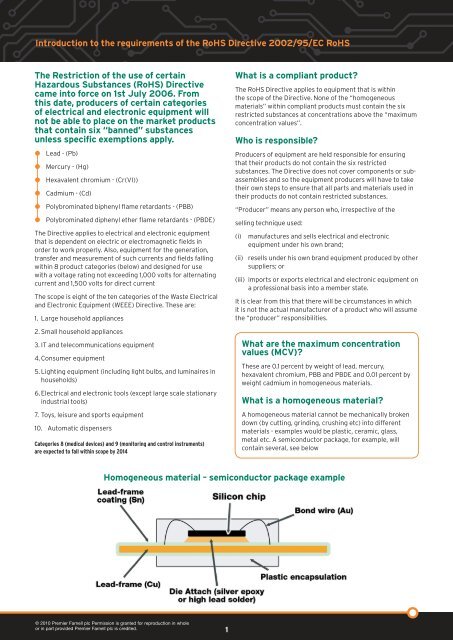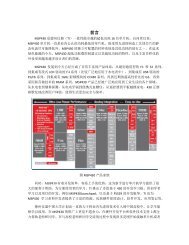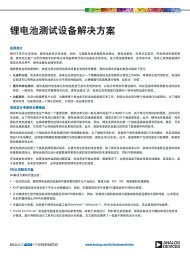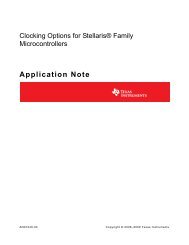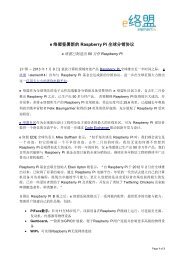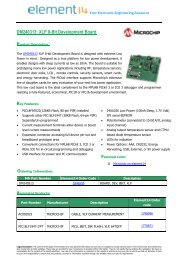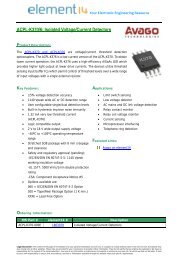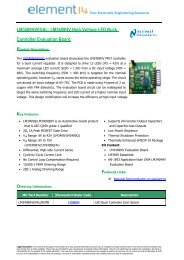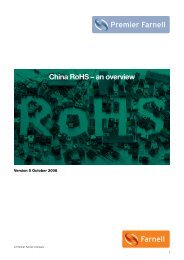RoHS Directive Technical Guide
RoHS Directive Technical Guide
RoHS Directive Technical Guide
Create successful ePaper yourself
Turn your PDF publications into a flip-book with our unique Google optimized e-Paper software.
Introduction to the requirements of the <strong>RoHS</strong> <strong>Directive</strong> 2002/95/EC <strong>RoHS</strong><br />
The Restriction of the use of certain<br />
Hazardous Substances (<strong>RoHS</strong>) <strong>Directive</strong><br />
came into force on 1st July 2006. From<br />
this date, producers of certain categories<br />
of electrical and electronic equipment will<br />
not be able to place on the market products<br />
that contain six “banned” substances<br />
unless specific exemptions apply.<br />
z<br />
z<br />
z<br />
z<br />
z<br />
z<br />
Lead - (Pb)<br />
Mercury - (Hg)<br />
Hexavalent chromium - (Cr(VI))<br />
Cadmium - (Cd)<br />
Polybrominated biphenyl flame retardants - (PBB)<br />
Polybrominated diphenyl ether flame retardants - (PBDE)<br />
The <strong>Directive</strong> applies to electrical and electronic equipment<br />
that is dependent on electric or electromagnetic fields in<br />
order to work properly. Also, equipment for the generation,<br />
transfer and measurement of such currents and fields falling<br />
within 8 product categories (below) and designed for use<br />
with a voltage rating not exceeding 1,000 volts for alternating<br />
current and 1,500 volts for direct current<br />
The scope is eight of the ten categories of the Waste Electrical<br />
and Electronic Equipment (WEEE) <strong>Directive</strong>. These are:<br />
1. Large household appliances<br />
2. Small household appliances<br />
3. IT and telecommunications equipment<br />
4. Consumer equipment<br />
5. Lighting equipment (including light bulbs, and luminaires in<br />
households)<br />
6. Electrical and electronic tools (except large scale stationary<br />
industrial tools)<br />
7. Toys, leisure and sports equipment<br />
10. Automatic dispensers<br />
Categories 8 (medical devices) and 9 (monitoring and control instruments)<br />
are expected to fall within scope by 2014<br />
1<br />
What is a compliant product?<br />
The <strong>RoHS</strong> <strong>Directive</strong> applies to equipment that is within<br />
the scope of the <strong>Directive</strong>. None of the “homogeneous<br />
materials” within compliant products must contain the six<br />
restricted substances at concentrations above the “maximum<br />
concentration values”.<br />
Who is responsible?<br />
Producers of equipment are held responsible for ensuring<br />
that their products do not contain the six restricted<br />
substances. The <strong>Directive</strong> does not cover components or subassemblies<br />
and so the equipment producers will have to take<br />
their own steps to ensure that all parts and materials used in<br />
their products do not contain restricted substances.<br />
“Producer” means any person who, irrespective of the<br />
selling technique used:<br />
(i) manufactures and sells electrical and electronic<br />
equipment under his own brand;<br />
(ii) resells under his own brand equipment produced by other<br />
suppliers; or<br />
(iii) imports or exports electrical and electronic equipment on<br />
a professional basis into a member state.<br />
It is clear from this that there will be circumstances in which<br />
it is not the actual manufacturer of a product who will assume<br />
the “producer” responsibilities.<br />
What are the maximum concentration<br />
values (MCV)?<br />
These are 0.1 percent by weight of lead, mercury,<br />
hexavalent chromium, PBB and PBDE and 0.01 percent by<br />
weight cadmium in homogeneous materials.<br />
What is a homogeneous material?<br />
A homogeneous material cannot be mechanically broken<br />
down (by cutting, grinding, crushing etc) into different<br />
materials - examples would be plastic, ceramic, glass,<br />
metal etc. A semiconductor package, for example, will<br />
contain several, see below<br />
Homogeneous material – semiconductor package example<br />
© 2010 Premier Farnell plc Permission is granted for reproduction in whole<br />
or in part provided Premier Farnell plc is credited.


